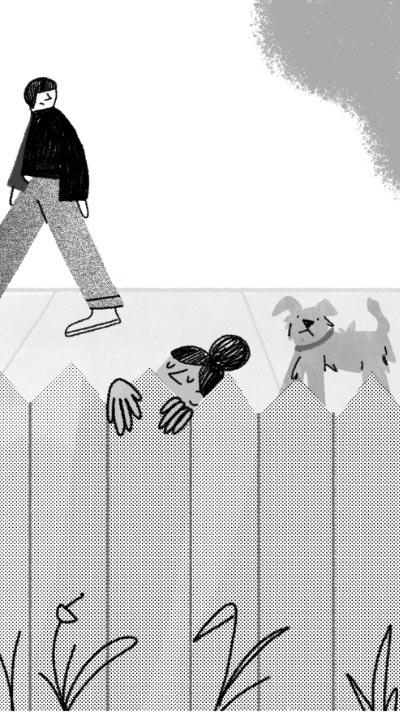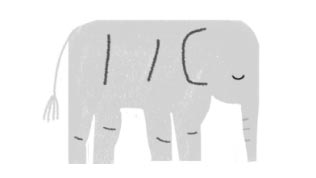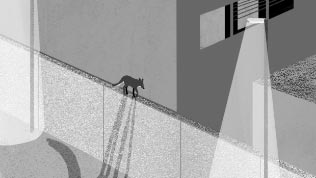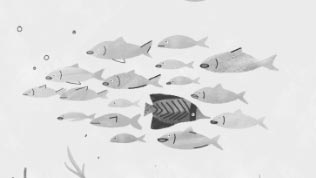Following dogs following us
by Alexandra Horowitz
Understanding the way dogs experience the world is life-changing.
I have been completely changed by dogs. Professionally, they have become my career: as a researcher into dogs' cognitive abilities, I study what they understand, how they solve problems and how they experience the world. On a personal level, they have provided an entry into a social world of people who are connected by the simple fact of having adopted a dog, allowing for all sorts of conversations with strangers. But it is in a constitutional sense that they have affected me the most, for they have changed how I see the world. And in this, my relationship with dogs broadly recapitulates the history of our species, since all humans - Homo sapiens - have been changed by Canis familiaris, the domestic dog.
One wants a beginning to the story: a moment when the first dog wags away from her pack and approaches the first human - who herself steps towards the dog. One imagines a moment that mirrors the greeting each of us receives every time we return home after an absence of an hour or a week: a reunion like no other, characterised by the enormous joy of the dog at seeing her person.
In fact, there was likely no single first moment for dogs and people. Many theorise that some wolves - proto-dogs - grew bold enough to approach the inchoate villages of humans in ancient times, feeding on their garbage and eventually earning a place inside the village. Others suggest that some humans intentionally plucked young wolves from their families to raise as guards or hunting companions. Whatever the beginning, we know what has happened since. We have lived with dogs for thousands of years, using, following and treasuring them. Initially, they enabled us to hunt more efficiently by sniffing out our quarry and to sleep more soundly by guarding our doors. Eventually, humans and dogs forged a relationship rare among animals, wherein the story of one species is completely interwoven with that of the other. Other inter-species relationships, mutually beneficial to both parties, are not unknown: honeybirds guide humans to beehives, African hornbill and mongoose share prey and warn each other about predators, clownfish protect and are protected by anemones, and various large herbivores host tick-eating oxpeckers on their backs. Quite beyond these though, the relationship between people and dogs has changed our habits, changed our homes and changed our minds.
To wit: every place I have lived in has had a dog - or many dogs - in it. I have chosen homes near parks, to enable thrice-daily walks with dogs. I have changed the interiors of those homes, to be carpeted for a dog who had trouble walking, or air-conditioned for a dog who ran hot, and all furnished with large enough sofas or beds to accommodate both bipeds and quadrupeds at the same time. But it was not until I began studying dogs that they changed my perception.
We humans are visual creatures: our ways of thinking, remembering, navigating and interacting are all rooted in sight. We have, as a species, bred dogs to look more to our liking. In some cases, this has meant breeding dogs with flatter faces that are more like ours. In others, we've bred dogs with characteristics evocative of the big-eyed, large-headed human toddler. We've bred them to be coloured, furred and tailed in a way that is visually pleasing to us. Yet no dog cares a whit about having a merle coat, or a broad forehead and jowls.
Dogs are creatures of the nose, exploring the world - and other dogs, and us - by smell. They live in a universe of odours that exists alongside our world but is rarely noticed by us. When we do sniff, it is typically in gustatory pleasure or brow-furrowing disgust. To dogs, smells are merely information. To know dogs then, I realised some years into studying them, I would need to know smells.
This is how I came, one sunny day, to be kneeling down by a short iron fence post, sniffing. One of our dogs, Finnegan, had been closely investigating the spot, his nostrils actively working, his cheeks ballooning slightly as he exhaled. To my eyes, there was nothing of interest there: a rusting fence ringing a tree planted in the pavement, futilely guarding it from any harm caused by creatures passing close by. Finn would show me otherwise.
As I put my nose to the fence post, I already knew certain things about dogs. I knew they have hundreds of millions more olfactory receptor cells - cells in their noses that can pick up odours - than we do. I knew that the olfactory lobe of a dog's brain, relative to the rest of the brain, is 20 times larger than ours. I knew that dogs have been trained to find narcotics, illegal electronics, bed bugs, endangered snakes, cadavers, truffles, brown bear scat and cows in heat. I knew that dogs have been proven to be able to detect cancer by smell, to spot dangerous blood-sugar levels in people with diabetes, to identify and comfort sad people and to find missing ones. I knew tracking dogs can determine the direction in which a missing person has fled by sniffing only five of their footsteps, distinguishing the concentration of the older smell of footstep one from the stronger concentration left two seconds on with footstep five. I knew dogs like to smell deeply and closely. That they recognise each other, me and themselves via smell. That they are likely experiencing time through smell, noting how the smells of a house settle during the day and reading outdoor smells as evidence of creatures past and future. That, through their noses, they know who carries dog biscuits in their pockets when walking in the park, who is stressed, who is fearful, who is young or old and who has recently coupled with whom.
But I did not know how it feels to live in that world, to be so attuned to the molecules floating in the air and to have my perception changed by a gusty wind scattering smells or by a cold day flattening them. My experience with smells was, perhaps, typically human. I knew a few odours well enough to imagine them in my head. I knew the smells of pencil shavings, honeysuckle, a ripe tomato. I knew the smells of all the fragrant foods, of American airports, of my grandparents' house. I knew the smell of the top of my son's head, the smell of the tobacco inside my father's desk, the smell of a dog-filled car. I had smells that I loved - the air above a rushing river, bread baking - and those that disgusted me - vomit, garbage on a New York City pavement on a warm day. But I could rarely name a found smell and I did not think in smells. We live in antiseptic times, where 'odour' is a thing to be eliminated from our environment and from our bodies (unless the odour is sold as a fragrance to be applied to our bodies to cover other odours).
A day spent watching dogs' relationships with smells is revealing. They emerge from sleep sniffing, their nostrils working to take in the smell of the morning. I greet them by bending close to their faces, allowing them to snuffle a 'hello'. Emerging from the house, their noses reach into the wind, then follow invisible trails on the ground. Each passing person and dog is accorded an investigative sniff, or a perfunctory snort. On encountering some dogs, each presses its nose deep into the other's fur - as if, to see one another fully, they must be mutually smushed into each other's eyes. One dog sniffs out an abandoned tennis ball under a hedge; another looks to find which other dog has left its mark on a fire hydrant. Play between dogs will be paused for a bout of mutual sniffing, checking each other's temperature.
And that is all before breakfast.
What I smelled at that iron fence post was: not much. Following Finnegan's example, I put my nose right up close to it - uncomfortably close, to be honest. A couple walking by on the pavement gave me a wide berth as they passed. To sniff, in our society, is not just rude, it is downright suspicious. I sniffed several times, trying to match the canine rate of seven inhales a second. I exhaled warm air to try to volatilise the molecules, to bring them into the air in my nose. I smelled something: Something sharp and bright and, happily, not at all urinous. Finnegan stood a distance away from me, looking at me intently. Whatever he smelled, I did not.
But I have since tried to learn about dogs' world of smell. I have subjected myself to research, to try to distinguish and name hundreds of molecules by scent. I have been schooled by perfumers and sommeliers on the olfactory notes of their crafts. I have watched tracking dogs track, and detection dogs detect. I now sniff before I drink or eat, I smell each book I read, each twig or leaf or pebble I collect. If I hold something in my hand, I bring it to my nose for a whiff; if I embrace a friend in a hug, I smell them (discreetly). I watch my dogs' noses with admiration and let them sniff the world at their pace. I did not become a dog, but they showed me what I was missing in being human.
This is not the only way in which I have been changed by dogs. They have changed other sensory renderings of the world for me as well. After living with Pumpernickel, who liked to walk along the side of a path, I found myself angling towards hedgerows and finding pleasure at approaching the single tree in a field, as she did. After Upton, I became attentive to the crash of sounds on a city block because he startled at each slamming door and rattling chain. Finnegan made me grin at post-rain puddling, in anticipation of the pleasure he would have in running through them. I walk on the shady side of a city block, just as my dogs would prefer. I lift fans from the floor, conscious of the rumbling they send through a lying dog's body. And if I had a tail, I would wag at each dog's approach on the sidewalk, in anticipation of meeting a new spirit.
Other people living with dogs may be less keen to follow their dogs in quite this way. They may be more moved by dogs' quiet companionship, by how they observe us and learn our habits, by their responsiveness to our call and to our attention. In all cases, dogs serve to remind us of a way of being that is just outside our experience. They hold a mirror to us, showing us who we are, but also giving a glimpse of who we could be. In letting us share their company, they allow us to see them and to see all non-human animals. For the dog has become a kind of ambassador for the rest of the animal kingdom and natural world, even as our attention is being stolen by technology. The dog beside you is a reminder that we share this planet, and that our sphere of concern can and should be greater than that which tightly encircles humans. Live with a dog? As familiar and commonplace as it is, it may be one of the most profound and significant things we do as people.

Alexandra Horowitz
Alexandra Horowitz is senior research fellow and head of the Dog Cognition Lab at Barnard College, where she also teaches seminars in canine cognition, creative nonfiction writing, and audio storytelling. She is the author of the bestselling Inside of a dog: What dogs see, smell and know (Scribner 2009) and four other books, most recently The year of the puppy (Viking 2022). She lives with her family of Homo sapiens, Canis familiaris and Felis catus in New York City.
Sam Gaines
Head of Companion Animals
Daily exercise away from the home is one of the key opportunities for dogs to receive information through scent but our behaviour can often affect their ability to do so. As people, we often view exercise in terms of its physical benefit; increasing our daily step count or moving at a pace to keep our heart rate elevated. But for many dogs, frequent stopping to sniff objects like lamp posts or logs is key as they hold vital information about other dogs who have left their own scent marks packed with details about themselves. Likewise, many dogs want to meet and greet other dogs so that they can intensely sniff faces, ears and other areas, extracting as much information as possible from one another.
Alexandra's essay is an eloquent reminder of how different the world is for dogs compared to people, why we need to be in tune with the needs of our canine companions and what we can do to provide opportunities for our dogs to use their noses so that they feel happy and are able to thrive alongside us. It helps us to be more #DogKind.



